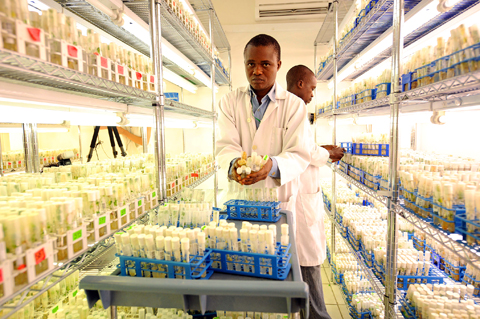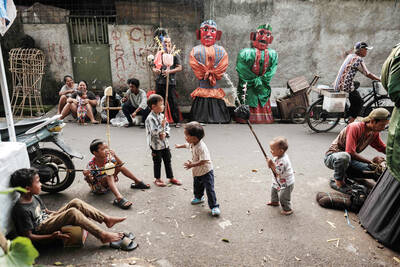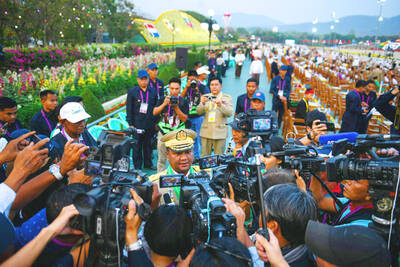The “magic” cassava roots the Nigerian farmer pointed to might have made Charles Darwin smile — and they may also turn out to be part of the solution to hunger across swathes of Africa.
“If you uproot it, you can see six or seven tubers,” said Bashir Adeyinka Adesiyan, a farmer from southwestern Nigeria, the world’s largest producer of cassava. “The one we were planting before, you would only get two or three.”
He called it a “magic plant.”

PHOTO: AFP
Scientists in Nigeria and six other African nations are experimenting with a fast-yielding, disease-resistant species of cassava, a root useful in so many ways that Darwin, the father of evolution theory, once marveled at its diversity.
Workers have to frighten off porcupines seeking to feast on the chubby new cassava stems on Adesiyan’s farm, where a crooked path divides the old species from the new, grown side by side to be able to compare them.
The results so far are glowing: The new plants stand taller and appear stronger and more vibrant. When their tubers are pulled from the ground, they resemble fat, oversized fingers.
The cassava stems are not genetically modified. They were obtained through a conventional process of breeding and selection over more than a decade.
Researchers at the International Institute of Tropical Agriculture (IITA) are distributing the stems to local farmers free of charge.
They hope to get the improved cassava into 75,000 farms by the end of this year to increase yields in seven selected Nigerian states.
It was a carnival-like scene recently in the farming town of Ifon in southwestern Nigeria as officials distributed 1,500 packs of the new cassava stems, with traditional Yoruba drumming and dancing.
Bintu Aderemi, a 55-year-old woman cassava farmer, said the stems “are God-sent. They thrive well and I am very happy.”
Developed in response to the 2008 global food crisis, the project is first aimed at tackling hunger in Africa — particularly in drought-hit Chad and Niger.
However, the versatile cassava plant — which has a wide range of industrial uses — could also one day provide a much-needed raw material to meet China’s growing needs, becoming a potentially lucrative export crop for Africa. The first results have been promising, scientists and farmers say.
Financed by US Agency for International Development, the project targets about 400,000 farmers directly in seven African nations: Sierra Leone, Ghana, Tanzania, Malawi, the Democratic Republic of the Congo, Mozambique and Nigeria, IITA officials said.
“We want to double their yields,” IITA’s Nigeria coordinator Richardson Okechukwu said.
The US$5.3 million project in Africa “will ensure food security for Nigerians and neighboring northern countries like Niger and Chad, and will also provide more roots for large-scale cassava industries,” he said.
Cassava is one of the world’s largest sources of carbohydrates and is eaten in various forms in a long list of countries. In Nigeria, it is ground up for traditional dishes, such as garri and fufu, which are types of porridge served with soup.
In some African countries, including Nigeria, Liberia, Sierra Leone and the Democratic Republic of the Congo, cassava leaves are also consumed for their protein, Okechukwu said.
Long-term, African farmers also stand to make a potential profit from the new strain of cassava, whose industrial uses include the manufacture of tires, adhesives, ethanol, pharmaceuticals, biofuels and livestock feeds.
“China could buy almost everything we produce. That is in the future,” IITA director-general Peter Hartmann said.
The crop could be an opportunity for farmers in Nigeria, where agriculture has played a diminished role in the economy dominated by oil.
Though Nigeria leads the world in cassava production — 44.6 million tonnes in 2008, according to the UN Food and Agriculture Organization — it is mainly for domestic consumption. Thailand is the world’s largest exporter of cassava.
“We know that with climate change and the increased drought, definitely there is going to be more and more demand,” Hartmann said.

In the sweltering streets of Jakarta, buskers carry towering, hollow puppets and pass around a bucket for donations. Now, they fear becoming outlaws. City authorities said they would crack down on use of the sacred ondel-ondel puppets, which can stand as tall as a truck, and they are drafting legislation to remove what they view as a street nuisance. Performances featuring the puppets — originally used by Jakarta’s Betawi people to ward off evil spirits — would be allowed only at set events. The ban could leave many ondel-ondel buskers in Jakarta jobless. “I am confused and anxious. I fear getting raided or even

Kemal Ozdemir looked up at the bare peaks of Mount Cilo in Turkey’s Kurdish majority southeast. “There were glaciers 10 years ago,” he recalled under a cloudless sky. A mountain guide for 15 years, Ozdemir then turned toward the torrent carrying dozens of blocks of ice below a slope covered with grass and rocks — a sign of glacier loss being exacerbated by global warming. “You can see that there are quite a few pieces of glacier in the water right now ... the reason why the waterfalls flow lushly actually shows us how fast the ice is melting,” he said.

RISING RACISM: A Japanese group called on China to assure safety in the country, while the Chinese embassy in Tokyo urged action against a ‘surge in xenophobia’ A Japanese woman living in China was attacked and injured by a man in a subway station in Suzhou, China, Japanese media said, hours after two Chinese men were seriously injured in violence in Tokyo. The attacks on Thursday raised concern about xenophobic sentiment in China and Japan that have been blamed for assaults in both countries. It was the third attack involving Japanese living in China since last year. In the two previous cases in China, Chinese authorities have insisted they were isolated incidents. Japanese broadcaster NHK did not identify the woman injured in Suzhou by name, but, citing the Japanese

RESTRUCTURE: Myanmar’s military has ended emergency rule and announced plans for elections in December, but critics said the move aims to entrench junta control Myanmar’s military government announced on Thursday that it was ending the state of emergency declared after it seized power in 2021 and would restructure administrative bodies to prepare for the new election at the end of the year. However, the polls planned for an unspecified date in December face serious obstacles, including a civil war raging over most of the country and pledges by opponents of the military rule to derail the election because they believe it can be neither free nor fair. Under the restructuring, Myanmar’s junta chief Min Aung Hlaing is giving up two posts, but would stay at the